Epoch Electronic War Game: Battle of Dan-no-ura (1984)
Though most of my research into 1980s Japanese board games has focused on Bandai’s prodigious output, they had several competitors in that era, including Hobby Japan, Tsukuda Hobby, Epoch, Takara, Hanayama, Enix, and Nintendo. During their brief stint into wargames (c. 1981–84) via the “Game for Adult if Series,” Bandai’s two primary competitors were Tsukuda Hobby and Epoch.
There’s a nice history of Japanese wargames on this wargaming blog, but the short version is as follows: Hobby Japan introduced Japanese players to American and European wargaming in 1972, first in its magazine coverage then later by importing English-language titles with Japanese rules translations. The influx of Avalon Hill and SPI titles meant that the mechanics, style, and vocabulary of these games (e.g., ‘adult games,’ ‘zone of control,’ scenario-based combat) seeped into the lexicon of Japanese players. By the end of the 70s, a niche wargaming culture was established in Japan, and many players were creating their own rule variations shared through meet-ups and hobbyist magazines.
But an important economic shift happened in the early 70s that changed the Japanese wargame landscape. The fixed yen-dollar exchange rate established after World War II was set afloat after two decades of artificial stability. As the Japanese yen sank in value against the dollar, Hobby Japan’s import business became untenable, opening the door for wargames designed domestically. Enter Bandai, Tsukuda, and Epoch.
Each company offered its own style of marketing, design, and play, but the impact on Japanese board games had a few important trends. Foremost was the shift in focus from American- and Euro-centric content to Japanese-specific scenarios. While Bandai, Tsukuda, and Epoch all released games in the popular WWII theater (which is, in itself, interesting from a Japanese perspective), culturally-significant conflicts, eras, and personalities from Japanese history began to appear more frequently. The Genpei War, Sengoku period, Nobunaga, the Siege of Osaka, and Sekigahara all made multiple appearances in Japanese wargames.
Equally important was the (characteristically Japanese) hybridization of wargames with other emergent genres. Though Epoch stuck with historical simulations, both Bandai and Tsukuda launched, respectively, the “SF・アニメタイプ” (SF/Anime Type) and the “SF・Series” sub-groups within their mainline wargame series. In both cases, SF stood for ‘science fiction,’ but not in the narrow sense we think of today. There were plenty of mechs, monsters, and familiar genre licenses (e.g., Star Wars and Star Trek), but for Tsukuda especially, science fiction comprised elements from sci-fi, anime, pop culture, and fantasy, including swords-and-sorcery-style roleplaying games. In America, the rise of sci-fi/fantasy within wargaming famously led to a schism wherein the grognard wargamers clung to realistic simulations of historical warfare, while the fantasy folks pursued the path of Chainmail and Dungeons & Dragons. But Japanese publishers seemed content to serve players of all types, regardless of genre conventions. Wargame rules served equally well for Germany, Genpei, Gundam, and Godzilla.
Epoch EWE
Meanwhile, Epoch launched a sub-series of their own in 1983 called EWE, or Epoch Wargame Electronics. Aimed at slightly younger (or beginner) players, the EWE series distilled hex-based wargames to a few key mechanics, a small turn count, limited units, and focused scenarios. Beyond these refinements, EWE games had other gimmicks: a unique plastic frame, metal board, magnetic units, and, true to the series’ name, an “electronic judgment device” (電子判定装置) to help decide battle results.
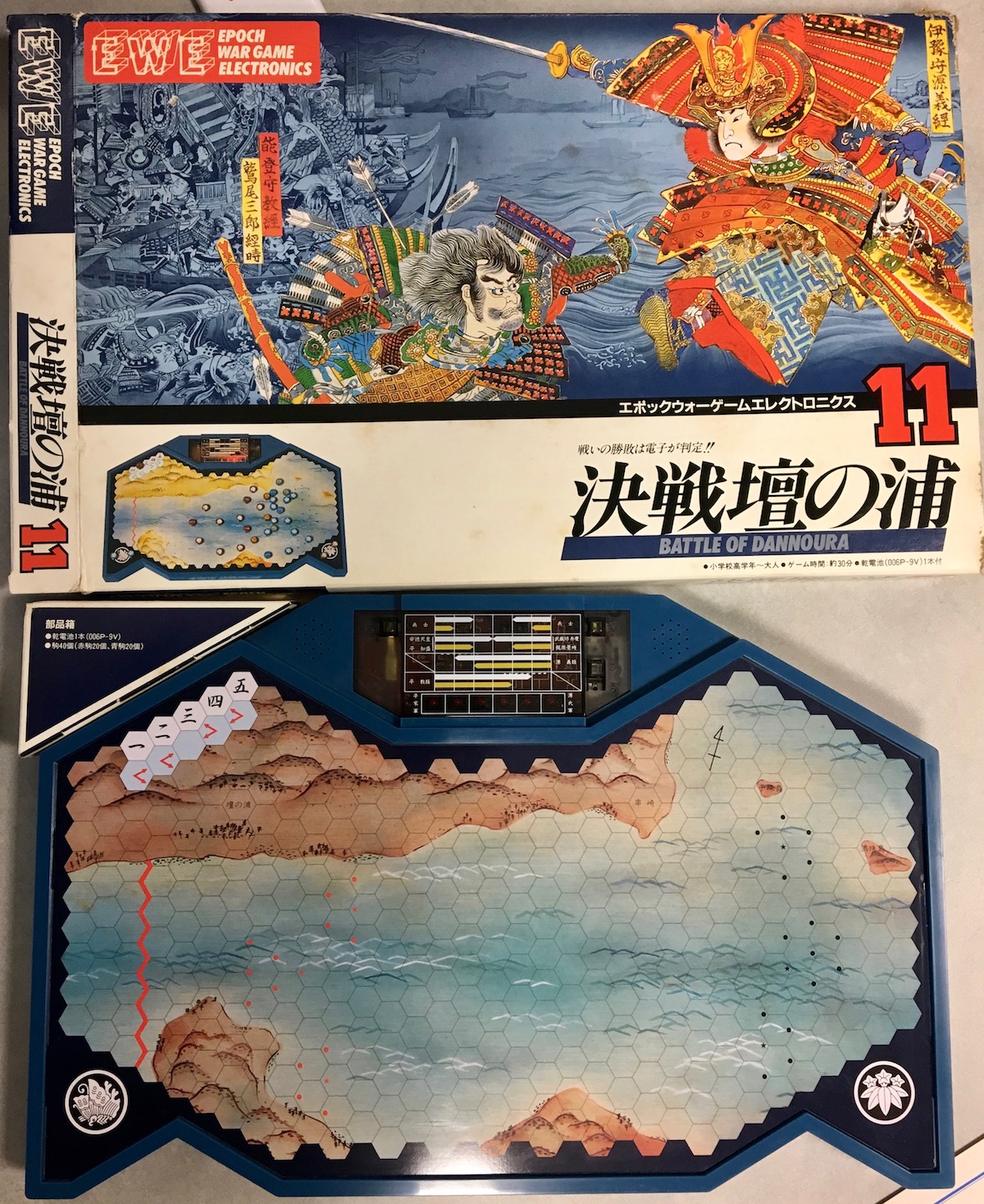
The frame has a curious design. First, it’s just over an inch tall, so the board is raised like a platform. Second, it has a distinctive “bat” shape, as if someone cut two squat, isosceles triangles from the bottom of a standard rectangle, transposed them to the top, and wedged an electronic display in between. I can’t think of many reasons why Epoch chose that industrial design, other than its vague resemblance to two hexes and the fact that it looks rad as hell. The design serves no gameplay purpose that I can see, besides forcing the designers to sculpt their maps to its unconventional fanged U-shape. Lastly, the frame is much smaller than it seems in photographs. It measures roughly 9.5″ wide and 14.5″ lengthwise, roughly equivalent to a Chemistry textbook laid open. Accordingly, the hexes are a mere 0.25″ on each side, and the circular magnetic units have a 0.25″ diameter.
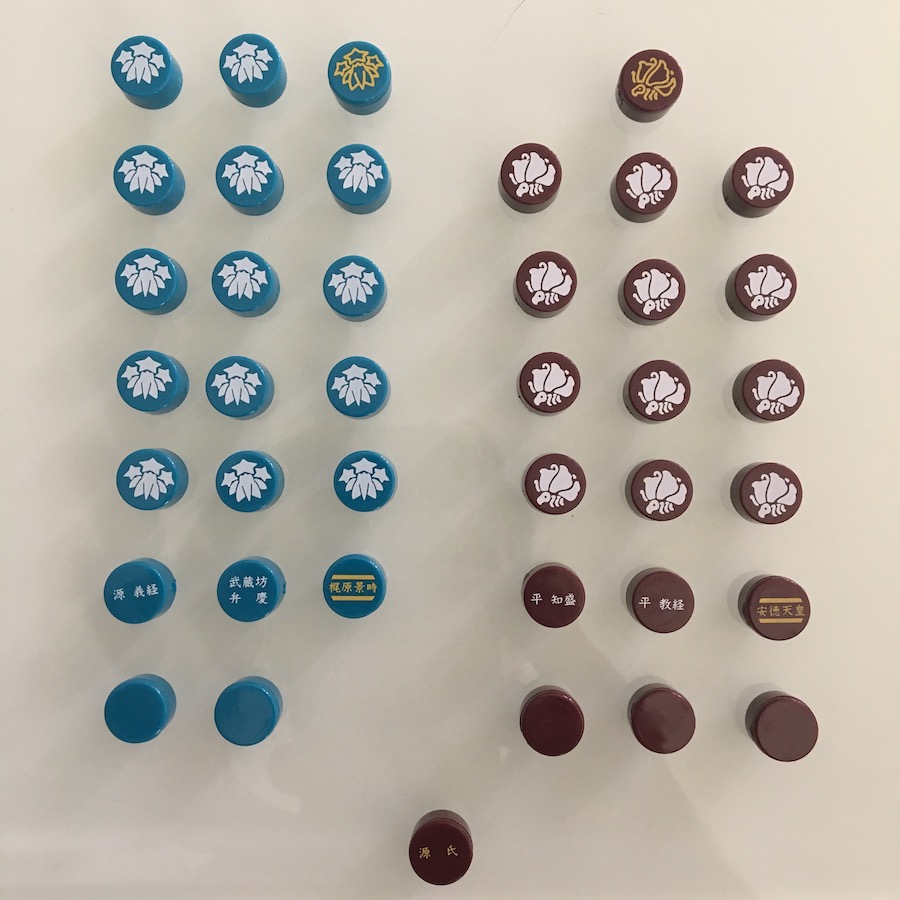
Most of the EWE games come with 40 units, typically split evenly between the opposing forces, and each unit is double-sided to indicate binary states (e.g., turn order, unit damage). The units are 0.25″ tall plastic cylinders with a tiny magnet sealed inside. If you shake one, you can hear the magnet rattling, which allows it to fall to the bottom when the unit is flipped while keeping the height of the unit large enough to pick up during play.
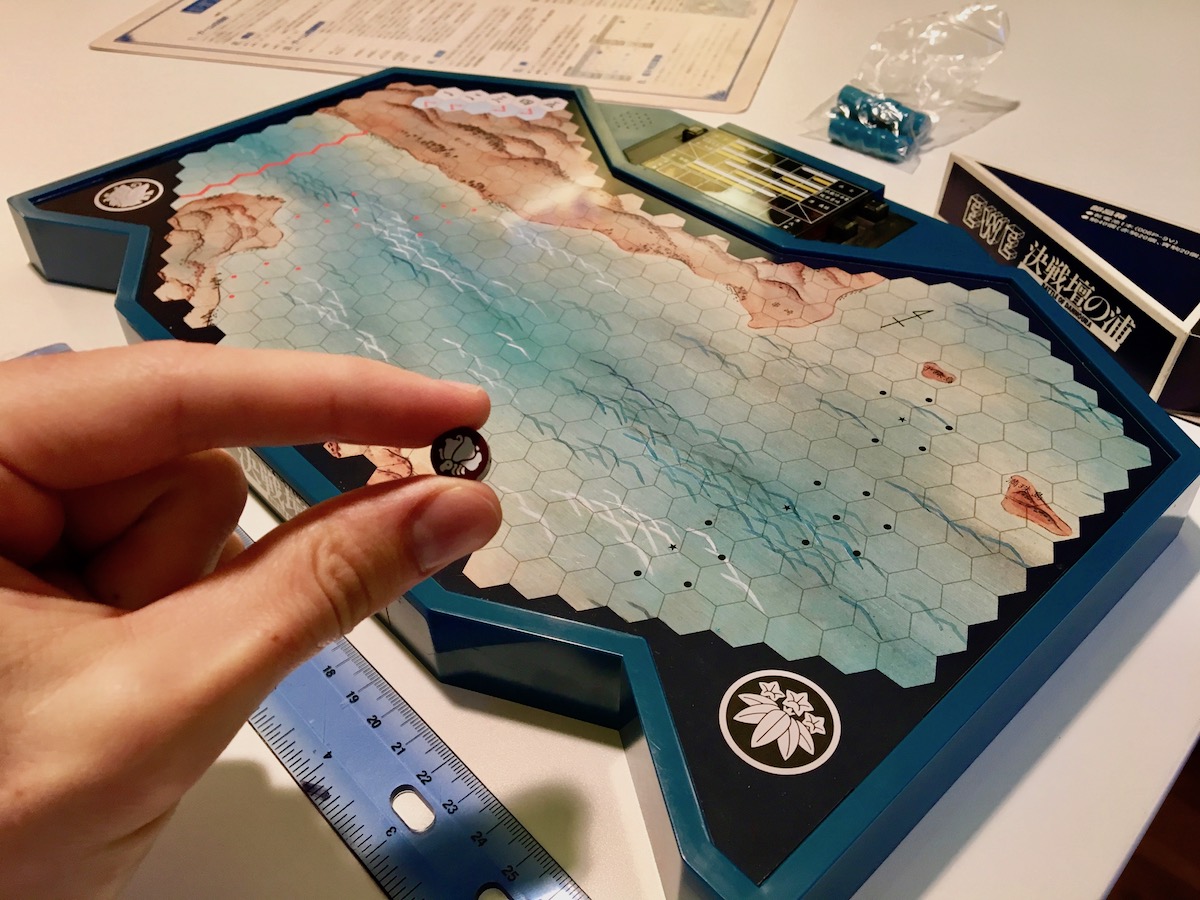
The featured ‘electronic judgment device’ is a simple circuit that randomizes which red LED is lit in a 6-LED sequence. In other words, it’s an electronic d6 roll (which makes it trivial to replicate if your unit is broken or you don’t have a 9V battery handy). There’s an ON/OFF switch and a PUSH switch on either side, one for each player. PUSH ‘rolls the dice,’ creating an audible series of chirps that broadcast through a small piezo housed behind the frame’s left speaker grill. The dual speakers give the illusion of stereo sound, but the right grill is cosmetic—there is no piezo behind it. As far as I can tell, both buttons trigger the same randomization circuit. My guess is that Epoch included two so each player could have their “own” button, which I’m sure led to arguments over each button’s perceived “fairness.”
Finally, the board, units, battery, and rules all fit within a slender box shaped to match the exact (rectangular) dimensions of the board frame. Cleverly, Epoch designed a wedge-shaped box to store the units and battery, so it rests snugly above one of the frame’s two wings. Likewise, all of the EWE games have their rules formatted to fit on a box-sized, double-sided cardboard sheet.
The Battle of Don-no-ura
I own the penultimate game in the EWE series, number 11, 決戦壇の浦 The Battle of Dan-no-ura. As the rule sheet summarizes (with my translation following), this battle is the conclusive maritime conflict of the Genpei War:
このゲームは、元暦2年(1185年)源氏、平家の最後の戦いである「壇の浦合戦」を模擬したウォーゲームです。プレイヤーはそれぞれ源義経率いる源氏と、平知盛率いる平家とに分かれ、源氏側は、平家の血筋をひく安徳天皇の潰滅を目的とし、平家側は、源氏の部隊を全滅させることを目的とします。
This war game simulates the final battle between the Genji 源氏 and Heike 平家, the “Battle of Dan-no-ura,” in the second year of the Genryaku 元暦 era (1185). Each player commands either the Genji army, led by Minamoto no Yoshitsune, or the Heike army, led by Taira no Tomomori. The Genji’s objective is to destroy Emperor Antoku, head of the Heike clan, and the Heike’s objective is to destroy the Genji’s forces.
The Genpei War (源平合戦) was a five-year conflict between two opposing clans in 12th-century Japan: the Taira (or Heike) and the Minamoto (or Genji). The war is historically significant because it established Japan’s nearly three-century rule under the feudal military Kamakura shogunate. The day-long battle at Dan-no-ura sealed the Genji’s victory, and it has become legendary in Japanese history due to its dramatic twists and turns. The following excerpts from the Tales of Heike provide one of the best contemporary accounts:
The Genji and the Heike boats were positioned on the sea about two miles apart. In the waters around Moji, Akama, and Dan-no-ura, the tidal currents are confused and turbulent. The Genji boats headed into the outgoing tide and hence, despite all their efforts, were constantly carried back. The Heike boats, however, were moving with the tide. […]
The Heike arranged their thousand or more boats into three groups…The Genji had more than three thousand boats, which meant that they were considerably superior in number. But the Heike’s arrows came winging from all directions so that it was difficult to determine just where their skilled archers were positioned. Yoshitsune was in the very forefront of the action, but the Genji were so pelted with arrows that they faltered, their shields and armor offering scarcely any protection at all. […]
So it was that all the fighting men of Shikoku and Kyushu turned against the Heike and threw in their lot with the Genji. Those who up to now had been models of obedience suddenly turned their bows on their own leaders or drew their swords to menace those who had been their commanders. When the Heike made for this or that shore, they found high waves impeding their approach; when they headed for this or that beach, they discovered the arrows of their enemies waiting for them. The long struggle between the Genji and the Heike for mastery of the realm was destined, it seemed, to end on this very day. (pgs. 135–140)
When the Heike army realized they were overcome, many of their officers leapt into the sea in lieu of being captured. Famously, the Emperor Antoku’s grandmother purposefully drowned herself and the child emperor, poetically ending the Taira’s rule.
Simulation Rules
Epoch’s take on Dan-no-ura models some of the key aspects of the historical battle:
- The Genji army (blue) begins with 18 units versus the Heike’s (maroon) 16, to reflect the former army’s manpower advantage.
- Both armies begin in three prearranged formations, each with a named leader (though you may choose which leaders head each group).
- During the battle’s 5 turns, the tide shifts twice. On turns 1 and 2, the tide favors the Heike. On turn 3, there is no tide. On turns 4 and 5, the tide favors the Genji.
- The Genji commander Yoshitsune’s unit ignores all enemy zones of control, giving him a significant tactical advantage.
- The armies have differing victory conditions: the Genji may win if they destroy the Emperor Antoku’s unit, manage to get two ships past the red ‘breakthrough line’ on the western edge of the map, or destroy enough Heike units to win via points; the Heike win by destroying Genji forces (and earn more points for eliminating Yoshitsune’s unit).
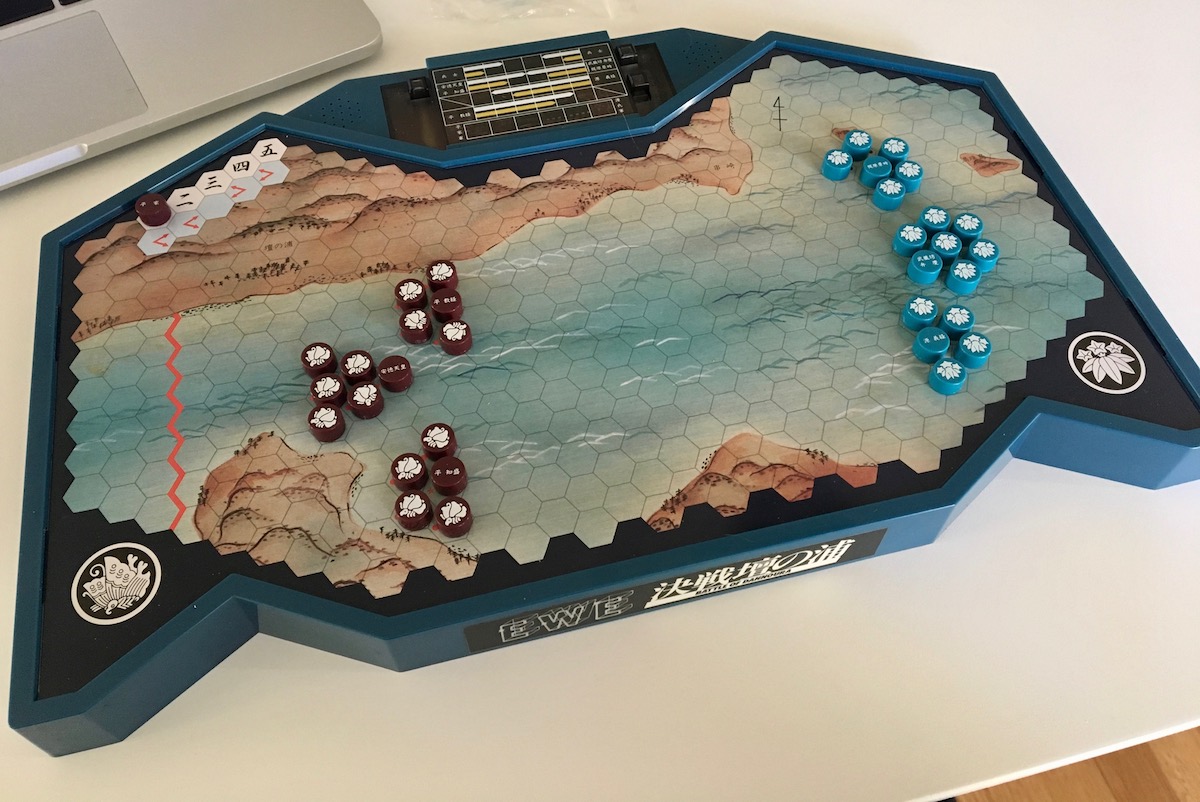
Each turn is divided into two rounds: Heike army actions then Genji army actions. Each army has the same sequence of actions available, in this order:
- Move
- Ranged attack (i.e. arrows)
- Melee attack (i.e. swords)
All undamaged units (white side up) have 12 Movement Power (MP) per turn. If any units are damaged (yellow side up) by a ranged attack, their MP drops to 8. When no tide is in play, each hex move costs 2 MP. With the tide active, it costs 1 MP to move with the tide, 2 MP to move perpendicular to the tide, and 3 MP to move against the tide. With the exception of Yoshitsune, any unit’s move ends immediately if they enter an enemy’s zone of control (ZOC), i.e. the six hexes directly surrounding the enemy’s position. In standard wargame fashion, a unit may not move out of a ZOC unless they first move into a non-ZOC hex. However, contrary to hex-and-counter wargame conventions, units may not stack.
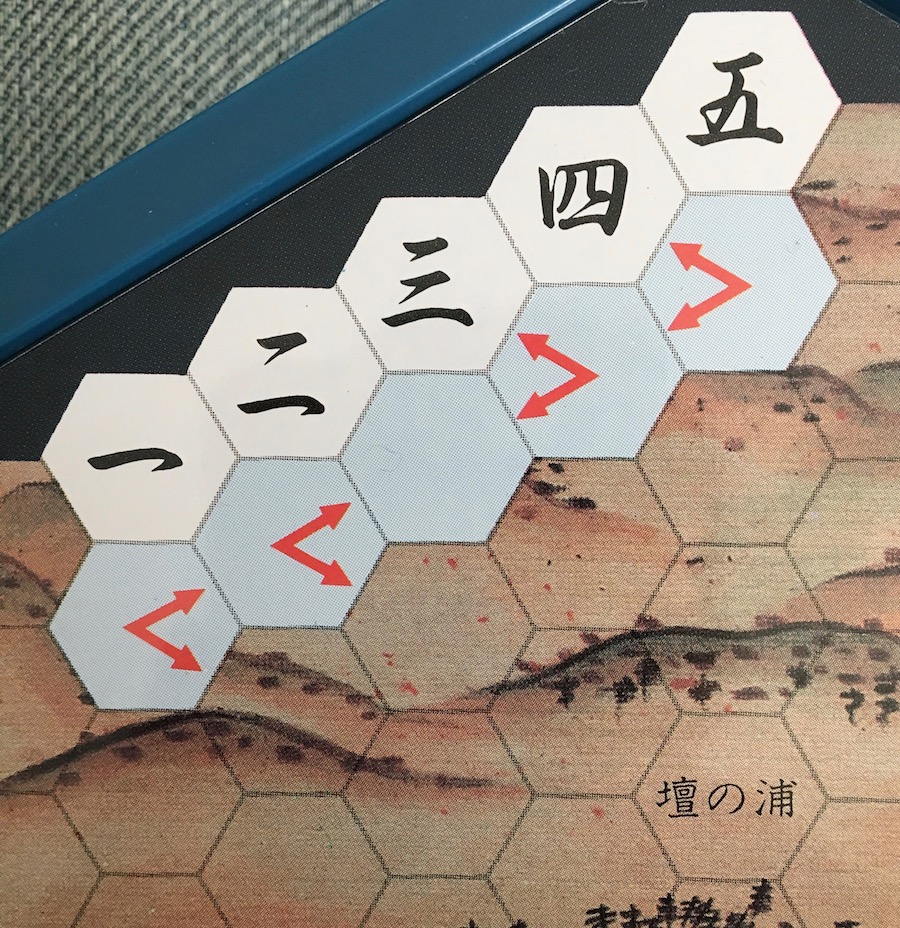
A unit may engage in ranged combat if a) they are 2 direct hex spaces away from the target unit (see figure below) and b) there is no unit—enemy or friendly—between their hex and the target hex. Ranged attacks are safe for the attacker; regardless of the combat result, the attacker takes no damage. However, ranged combat does ‘half’ damage. If an enemy is undamaged, a successful ranged attack puts them in a damaged state (flipped over); if they are already damaged, that unit is eliminated.

Melee combat, in contrast, is only possible within an enemy’s ZOC. Furthermore, a botched melee “roll” can eliminate the attacker, since melee combat is considered to be a simultaneous action between the attacker and defender. However, a successful melee attack eliminates the target unit, regardless of their current state.
A chart in the rules lists each unit’s Combat Power, but these numbers (ranged 1–5) never factor into calculations. Instead, you make a simple visual comparison on the electronic judgement device (EJD). The EJD display is divided into six columns, corresponding to each 1–6 result on the LEDs (which are confusingly not aligned with the results columns). Each army’s unit are listed on the left (Heike) or right (Genji) and sorted by name. Both the Genji and Heike armies comprise standard, unnamed units and three named units with higher combat statistics. The EJD’s white and yellow bars represent each unit’s Combat Power. To resolve combat, the attacking player presses the EJD’s PUSH button and interprets the result based on who is participating in the battle and how their Combat Power bars overlap. If, for instance, a standard, undamaged Heike unit (left side, top row) engaged in melee with an undamaged Yoshitsune (right side, third row from the top), the following results would apply:
- 1: Heike army unit win; Yoshitsune unit destroyed
- 2: Draw; the white bars overlap, so neither unit wins
- 3–6: Yoshitsune unit wins; Heike army unit destroyed
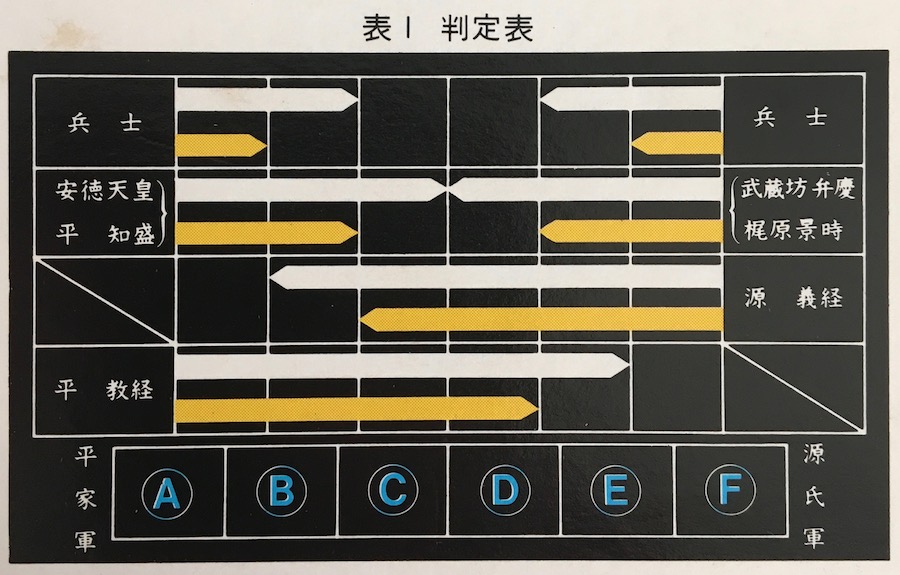
If either unit was damaged, they would interpret the combat roll based on their yellow bar instead (though in this example, the results would be the same). It’s a straightforward, proportional combat mechanic that allows even the lowliest army to defeat the opposing side’s commander (albeit with only a 16.6% chance of success).
I’ve only played two solo games so far, but it’s an elegant, satisfying system that has just enough mechanical complexity to reward careful tactical planning. The shifting current is particularly clever—advancing the Genji during the opening two turns is daunting, especially as you watch the Heike advance quickly into strategic ranged positions. Yet Yoshitsune’s movement advantage is a nice thematic counterbalance. Weaving through enemy positions, especially as the tide turns to the Genji’s advantage, makes Yoshitsune feel like a tactical genius.
On the negative side, the tiny units look nice, but they’re tough to manipulate with adult hands. Likewise, it’d be helpful to have some way to track which units have already moved and attacked in a turn. I’ve had to take photos to use as reference so I don’t cheat against myself. Finally, the rules don’t state whether hexes near the coast count as land or sea. I’ve assumed they are impassable, since counting them as valid sea tiles would create a wider tactical berth for the Genji forces to navigate.
As I play more (and hopefully with others), I’ll post updates on the game’s longterm strategies. For now, if you’re interested, you can check out my rules translation, alongside the original Japanese text and illustrations. (Note: Some translations are still provisional, but the bulk of the work is done. If you have suggestions or revisions, please let me know.)